The Dark Knight – Perfection in Execution
‘The Sequel’ is a concept which has garnered a lot of debate; the main question arising is whether the sequel is as worthy as the first installment and the answer to this question is not straightforward nor is there a fast and easy rule. However one need only mention the following titles to receive general affirmation as to the superiority of the sequel: The Godfather II, Star Wars: The Empire Strikes Back, Aliens, to name but a few. These films have a genuine following and the fans are very vociferous that the sequel is far superior to its predecessor. However it’s important to note that neither these fans nor this writer believe that all sequels are superior, but that every once in a while, the technical and creative planets align to endow filmmakers the ability and opportunity to create nothing short of film perfection. Having said that, it is my contention that particularly with superhero films; the second film is always superior, the reason for this is that the aim of the first film is to introduce a believable environment whereby the inception of our hero is brought about. However it is only in the second film where our hero is truly tested and this requires a stronger story and far more interesting villains.
To deliver such a film is by no means a small feat as the creator has to weave together complex storytelling and a development of the characters, introducing nothing short of an existential crisis to both the hero and the villain. And how is this done you may ask, quite simply through a well written script and its interpretation and execution by the cast and the crew. The Dark Knight is just such an example; its script and structure weaves in a multitude of clues that are delivered almost subconsciously and under the radar so that when you reach the end, a part of you feels that you sensed this outcome and yet the other part of you is shocked and brought to the very edge of your seat with anticipation and a desire for a happy resolution. What The Dark Knight achieved is a near mathematical execution of its script, a structure nearing precision and perfection and a story which weaved complexity and logical harmony seamlessly.
The basic principles of a film structure
The basic principle of drama is the three-act structure. Aristotle put forth that, “a whole is what has a beginning and middle and end”. The three acts are ‘protasis’ which is the introduction, ‘epitasis’ which is the main action and finally the ‘catastrophe’ which is the resolution of the story. In film this three act structure is played out as thus; film begins with an introduction to the environment, characters and the story. A crisis then occurs which unsettles the stability in the previous act and requires its characters to take action. And finally a resolution is brought about which directly deals with the crisis in the previous act allowing the characters to resolve the calamity and once again return to the stability of the first act. One act must follow from the previous and finally link back to the original, creating a perfect cycle of development. The execution of the structure should show a logical progression, i.e. each element has a unique predecessor and successor. Every image, spoken word and scene should come forth from the scene before it and lead to the next scene. Even when a film employs a non-linear structure such as Memento for example, the logic remains singular and ever expanding, that is, each shot and scene should provide more information than previously had.
Batman Begins followed the above outline of a central three-act structure, in that the hero and the city are introduced, secondly a crisis occurs with the introduction of the true intentions of the villain and finally the resolution comes about when the hero finally accepts his position as a hero and brings about peace by facing the foe who was a friend – thereabout bringing the film into a full circle. In order to ensure a successful follow-up, The Dark Knight had to achieve a multifaceted structure: firstly by introducing complicated characters in the face of The Joker and Two-Face, developing the main character by giving him inner turmoil and finally by creating an intricate story line as well as set up the final film in the trilogy.
The central basic structure of The Dark Knight is as follows: the characters are introduced; a crisis occurs when The Joker demands that Batman be unveiled and finally a resolution takes place when The Joker is finally captured. The beauty of this film is the intricate structure woven into the above central one. If I had to paint an image to better illustrate this point, the basic outline of The Dark Knight can be likened to a human skeleton, whilst the complex structure are like the veins and arteries that twist and weave around the main bones providing support.
It is precisely this intricate structure that I would like to highlight, by referencing particular scenes where the clues are unveiled, story is clarified and characters are made more empathetic. In order to outline the intricacy of this film, I will aim to document both the central and intricate structures to better illustrate how the finer structure served to bring about an overall superior film.
Act One
The purpose of the central structure in this act is to introduce the audience to all the characters specifically beginning with the one, who will become central to the story, that of the villain: The Joker. I say ‘specifically’ because the purpose served by introducing the villain first is to immediately present the audience and the hero with the crisis which will require a resolution within the span of the film. What this also serves to do is to create suspense which is the feeling of anxiety about an unforeseen future. Therefore from the very first scene, the creators have fashioned the anticipation for resolution, requiring us to watch with bated breath till the end.
Beside the main character, Batman, the second most important character is Harvey Dent a.k.a Two Face. I place Dent before Batman because it is Dent’s destiny which determines the journey and ‘ending’ of Batman; and how better to introduce Dent than through a conversation between the two main and original characters: Batman and Gordon. Dent is not merely introduced, but we are given clues about his character; firstly, whether he’s trustworthy and secondly how alike to Batman he is (you don’t have to wonder for very long to realise that both Batman and Two Face are split personalities battling themselves).
The subtlety of introducing such an important character through conversation is precisely the intricate structure at play; therefore the audience develops a vision of him before we even meet him. The scene plays as follows:
Another character of interest is Ramirez. Upon meeting her in this scene, the audience wouldn’t immediately understand her relevance in the story. The below conversation can easily be dismissed, however this particular scene serves to provide an important clue about a plot point/location: General Hospital. Furthermore, her introduction is not to merely sow the seeds of things to come but also (and little do we know) because Ramirez becomes the character which helps ignite the flames with the kidnapping of Rachel – she being the ‘pivotal’ character keeping both Batman and Harvey Dent ‘good’. This seemingly harmless little conversation sets up the crisis and action of the film:
And finally, the character of Rachel is re-introduced to the audience as Harvey Dent’s colleague and love interest – it is she who first refers to Dent as the ‘white knight’ and bringing about the symbolic meaning of the characters. The relevance of Rachel is her link to both Dent and Batman – the scene which exemplifies the intricate relationships between our main characters is the one when Bruce Wayne first meets Dent. Interestingly, just prior to this scene, Dent requests a meeting with Batman; little does he know that the man he meets is the very same man he wanted to meet.
The intricate structure is at play once again in the above scene – on the surface it serves to highlight the tension between Batman, Rachel and Dent, however it’s the words of Natascha which set the final scene of the film when she suggests that Gotham should not idolize a masked vigilante. Secondly it’s the scene where Batman first realises the idea of his retirement; however in hindsight you realise the relevance even more, it is not merely retirement which takes place but a role reversal between the very men in the above scene.
The dialogue in this scene continues as below and through it the audience is again given clues about the development of the story: the suspicion that Dent may be the caped crusader (he later confesses to a room full of press that he is Batman) and more importantly, Dent’s speech is used by Batman at the end of the film (“either die a hero or live long enough to see yourself the villain”).
Aside from introducing important characters, the intricate structure also serves to link the previous film to the current one by reminding the audience of the last villain. Once again, what the below will highlight is not a mere reminder, but the dialogue allows us an insight into the beginnings of Batman’s doubt. This scene appears near the beginning of the film where Batman finally captures Scarecrow and deals with his copycats, which in a later scene he says:
Act Two
Act two is where the action takes place and it tends to be the largest of the three acts. This is the act where Batman, Dent and Gordon bag Mr. Lau who directly leads to the arrest of the mob. It is also where The Joker raises the stakes by threatening Gotham City if Batman’s identity is not revealed.
The second act is also where we delve more into the characters, learning about their personal turmoil. In the case of The Joker, this insight is offered through his account of how he has come to have his facial scarring. His inner psychosis is revealed when we realise that he never tells the same story twice, and yet each time the story is more grotesque than the previous. His character is made far more interesting as we never quite learn why he is a villain – we are not given an easy psychological answer to his character and this is further backed up by something which Alfred says; “some men just want to watch the world burn.” This is a far more intricate character than audiences are used to, and the stories The Joker recounts of his trauma are mere ruses to both unsettle and mock the audience.
The Joker’s madness is balanced with tenderness which arises from Batman. It is in this film and in this act where we the audience understand how far Batman is willing to go in order to be with the woman he loves, and it is precisely this love which The Joker uses to break both Dent and Batman making evil men of good ones.
Apart from developing characters, the second act is where the clues introduced in the first come to fruition – an example of this is the unexpected death of Gordon and the clue here is Ramirez: it is she who delivers the bad news to Gordon’s wife. This scene appears rather innocuous; however the bearer of bad news is the very same person who we later realise has been helping The Joker. Gordon’s death is pivotal – he is after all the moral compass and pivot of the other characters – he is the link between Batman and Dent and of course without him, the balance is lost. It is Gordon’s death which causes Dent to question his morality, feeling that he must step up and act. The scene which best exemplifies this is where Dent uses his same-sided coin to threaten someone. Similar to the first act, this scene is used to set a standard of a character’s state and actions only for it to be later turned on its head. To further explain, the first time Dent threatens someone, we know the bareness of his threats, however when this scene repeats itself later in the film we are fully aware of the psychological break in the character and therefore the genuineness of the threat.
The Joker’s sheer genius is the manipulation of innocence; he is mad because he uses good characters and somehow turns them on a path of evil. Dent’s moral break is of course the work of non-other than The Joker through a sequence of events which can either be sheer luck or absolute calculating genius: Rachel’s and Gordon’s deaths and his facial burns all help to set Dent on the path of vengeance. Finally there is another character which is used to bring about the downfall of Batman: Reese.
The scene in question is where Reese, an employee of Wayne’s, demands to be paid off for his silence about the real identity of Batman. Fox’s reply noted below is sheer genius. What is important is that Reese’s decision to reveal Batman’s identity causes The Joker to focus his attention on him by turning the city against him. And it is this action which causes The Joker to blow up General Hospital (which of course is the location of Ramirez’s ill mother).
Before I go on to act three, I would like to include one final scene. I mentioned earlier that Nolan makes references to the third film in the series, and though the next films’ script is not yet complete at this stage, he has nevertheless inserted a line of dialogue, in fact, a mere word (italicised) which hints of things to come.
Act Three
Act three is where we will ultimately see a resolution and this is delivered poetically as Nolan truly makes us feel that the darkest hour is just before the dawn – it is in this act that Bruce Wayne announces to Rachel that he will walk away from being Batman. This plunges the audience into a dark pit of hopelessness; Gordon has died, Dent has lost his moral compass, the Joker is winning and now Batman is giving up. The last remaining symbol of good is Alfred and it is he who gives the audience hope by delivering the below wise words and ultimately planting the seed of Batman’s last action:
The key of third act is a play on good and evil. Through all the setups and clues established in the first and second acts, this is where we finally realise the game that The Joker has plunged us in. Firstly, The Joker forces a mortal decision onto Batman and Gordon in the scene where they have to choose who to save, Dent or Rachel (The Joker using what’s most important to the characters to manipulate their actions). For Batman, it is Dent who is most important as the moral character of Dent will allow Batman to reach his happy ending of retiring and being with Rachel. For Dent, it is Rachel, and her death causes him to act on rage and vengeance, which in turn forces Batman to endure.
This play on good and evil continues to feature in the film as The Joker then forces another mortal decision onto the people of Gotham City, by choosing their lives over the lives of criminals. This scene is very important as it is both the scene which finally breaks The Joker and re-establishes the moral compass of the film. The Joker places citizens of Gotham in a difficult situation to choose between life and death and their choice to sacrifice themselves for the greater good is what finally breaks The Joker.
But The Joker always has one last card and it is one even Batman does not anticipate: that of the fall of Harvey Dent, Gotham’s white knight and Batman’s replacement.
Like The Joker, Nolan has one last card too, one that even we the audience do not see coming: the fall of Batman. This scene leaves the audience heaving with anticipation for the next installment and brings about one of the most emotional and beautiful scenes – it is the culmination of everything we have experienced, and this resolution though not happy is the right and moral one and because it is so, we the audience weep that our hero must suffer for the greater good.
GORDON
The Joker took the best of us and tore him down. People will lose hope.
BATMAN
They won’t. They must never know what he did.
GORDON
Five dead. Two of them cops. You can’t sweep that…
BATMAN
No. But the Joker cannot win. Gotham needs its true hero. You either die a hero, or you live long enough to see yourself become the villain. I can do those things, because I’m not a hero, not like Dent. I killed those people. That’s what I can be.
GORDON
No, no, you can’t. You’re not.
BATMAN
I’m whatever Gotham needs me to be. Call it in.
GORDON
They’ll hunt you.
BATMAN
You’ll hunt me. You’ll condemn me. Set the dogs on me. Because that’s what needs to happen. Because sometimes, the truth isn’t good enough. Sometimes people deserve more. Sometimes people deserve to have their faith rewarded.
JAMES
Batman. Batman! Why’s he running, Dad?
GORDON
Because we have to chase him.
JAMES
He didn’t do anything wrong.
GORDON
Because he’s the hero Gotham deserves, but not the one it needs right now. So we’ll hunt him, because he can take it. Because he’s not our Hero. He’s a silent Guardian… a watchful Protector.
In summation, Christopher Nolan delivered a convincing sequel which not only built on the previous installment, but also set up the next one. His execution of the film was done with precision and care, ensuring that the development of each character was thorough and empathetic and the logical progression of each story line was tied up at the end. His mastery of such complex structure is profound and shows the true genius at work. I would not say this of any filmmaker, however in the case of Christopher Nolan, he is truly an auteur as he both wrote and directed the film ensuring a singular clarity of dictation.
Such work is worthy of universal appreciation. It is perhaps appropriate that the Oscars chose to honour it in the nominations. The film is deserving of many awards, but its true award must remain with the people and their consistent and regular enjoyment of it.

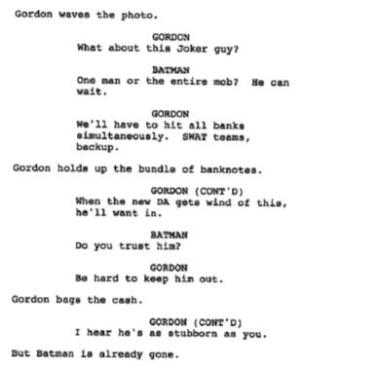
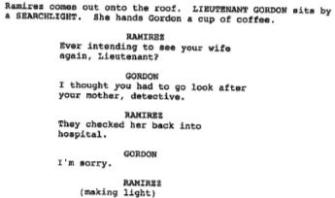
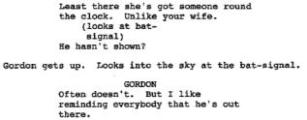
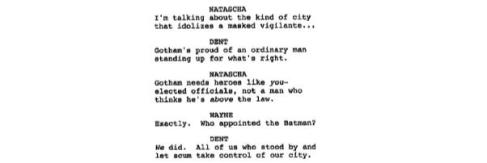
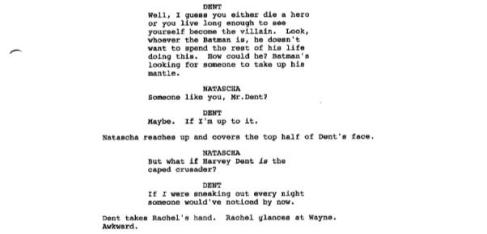

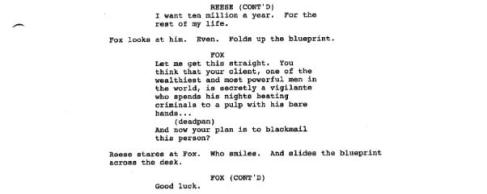







Leave a comment